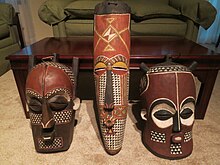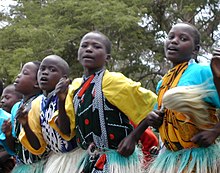The culture of Africa is varied and manifold, consisting of a mixture of countries with various tribes that each have their own unique characteristics from the continent of Africa. It is a product of the diverse populations that today inhabit the continent of Africa and the African Diaspora. African culture is expressed in its arts and crafts, folklore and religion, clothing, cuisine, music and languages.Expressions of culture are abundant within Africa, with large amounts of cultural diversity being found not only across different countries but also within single countries. Even though African cultures are widely diverse, it is also, when closely studied, seen to have many similarities. For example, the morals they uphold, their love and respect for their culture as well as the strong respect they hold for the aged and the important i.e. Kings and Chiefs.
Africa has influenced and been influenced by other continents. This can be portrayed in the willingness to adapt to the ever-changing modern world rather than staying rooted to their static culture. The Westernized few, persuaded by European culture and Christianity, first denied African traditional culture, but with the increase of African nationalism, a cultural recovery occurred. The governments of most African nations encourage national dance and music groups, museums, and to a lower degree, artists and writers.
Africa is divided into a great number of ethnic cultures.The continent's cultural regeneration has also been an integral aspect of post-independence nation-building on the continent, with a recognition of the need to harness the cultural resources of Africa to enrich the process of education, requiring the creation of an enabling environment in a number of ways. In recent times, the call for a much greater emphasis on the cultural dimension in all aspects of development has become increasingly vocal.[5] During the Roman colonization of North Africa,(parts of Algeria, Libya, Egypt and the whole of Tunisia) provinces such as Tripolitania became major producers of food for the republic and the empire, this generated much wealth in these places for their 400 years of occupation.[6] During colonialism in Africa, Europeans possessed attitudes of superiority and a sense of mission. The French were able to accept an African as French if that person gave up their African culture and adopted French ways. Knowledge of the Portuguese language and culture and abandonment of traditional African ways defined one as civilized.[7]Kenyan social commentator Mwiti Mugambi argues that the future of Africa can only be forged from accepting and mending the sociocultural present. For Mugambi, colonial cultural hangovers, pervasive Western cultural inundation, and aid-giving arm-twisting donors are, he argues, here to stay and no amount of looking into Africa's past will make them go away. However, Maulana Karenga states:
African arts and crafts
Africa has a rich tradition of arts and crafts. African arts and crafts find expression in a variety of woodcarvings, brass and leather art works. African arts and crafts also include sculpture, paintings, pottery, ceremonial and religious headgear and dress. Maulana Karenga states that in African art, the object was not as important as the soul force behind the creation of the object. He also states that All art must be revolutionary and in being revolutionary it must be collective, committing, and functional.
Certain African cultures have always placed emphasis on personal appearance and jewelry has remained an important personal accessory. Many pieces of such jewelry are made of cowry shells and similar materials. Similarly, masks are made with elaborate designs and are an important part of some cultures in Africa. Masks are used in various ceremonies depicting ancestors and spirits, mythological characters and deities.
In many traditional arts and craft traditions in Africa, certain themes significant to those particular cultures recur, including a couple, a woman with a child, a male with a weapon or animal, and an outsider or a stranger. Couples may represent ancestors, community founder, married couple or twins. The couple theme rarely exhibit intimacy of men and women. The mother with the child or children reveals intense desire of the women to have children. The theme is also representative of mother mars and the people as her children. The man with the weapon or animal theme symbolizes honor and power. A stranger may be from some other tribe or someone from a different country, and more distorted portrayal of the stranger indicates proportionately greater gap from the stranger. (HI)
Folklore and religion
Like all human cultures, African folklore and religion represents a variety of social facets of the various cultures in Africa. Like almost all civilizations and cultures, flood myths have been circulating in different parts of Africa. Culture and religion share space and are deeply intertwined in African cultures. In Ethiopia, Christianity and Islam form the core aspects of Ethiopian culture and inform dietary customs as well as rituals and rites. According to a Pygmy myth, Chameleon, hearing a strange noise in a tree, cut open its trunk and water came out in a great flood that spread all over the land.
Folktales also play an important role in many African cultures. Stories reflect a group cultural identity and preserving the stories of Africa will help preserve an entire culture. Storytelling affirms pride and identity in a culture. In Africa, stories are created by and for the ethnic group telling them. Different ethnic groups in Africa have different rituals or ceremonies for storytelling, which creates a sense of belonging to a cultural group. To outsiders hearing an ethnic group's stories, it provides an insight into the community's beliefs, views, and customs. For people within the community, it allows them to encompass their group's uniqueness. They show the human desires and fears of a group, such as love, marriage, and death. Folktales are also seen as a tool for education and entertainment. They provide a way for children to understand the material and social environment. Every story has a moral to teach people, such as good will prevail over evil. For entertainment, stories are set in fantastic, non-human worlds. Often, the main character of the story would be a talking animal or something unnatural would happen to human character. Even though folktales are for entertainment, they bring a sense of belonging and pride to communities in Africa.
There are different types of African stories: animal tales and day-to-day tales. Animal tales more oriented towards entertainment, but still have morals and lessons to them. Animal tales are normally divided into trickster tales and ogre tales. In the animal tales, a certain animal would always have the same character or role in each story so the audience does not have to worry about characterization. The Hare was always the trickster, clever and cunning, while the Hyena was always being tricked by the Hare. Ogres are always cruel, greedy monsters. The messengers in all the stories were the Birds. Day-to-Day tales are the most serious tales, never including humor, that explained the everyday life and struggles of an African community. These tales take on matters such as famine, escape from death, courtship, and family matters, using a song form when the climax of the story was being told.
Clothing
Women's traditional clothes in Ethiopia are made from cloth called shemma and are used to make habesha kemis. The latter garment is basically cotton cloth, about 90 cm wide, woven in long strips which are then sewn together. Sometimes shiny threads are woven into the fabric for an elegant effect. Men wear pants and a knee-length shirt with a white collar, and perhaps a sweater. Men often wear knee-high socks, while women might not wear socks at all. Men as well as women wear shawls, the netela.
Zulus wear a variety of attire, both traditional for ceremonial or culturally celebratory occasions, and modern westernised clothing for everyday use. Traditional male clothing is usually light, consisting of a two-part apron (similar to a loincloth) used to cover the genitals and buttocks. The front piece is called the umutsha (pronounced Zulu pronunciation: [umtifash]), and is usually made of springbok or other animal hide twisted into different bands which cover the genitals. The rear piece, called the ibheshu [ibeːʃu], is made of a single piece of springbok or cattle hide, and its length is usually used as an indicator of age and social position; longer amabheshu (plural of ibheshu) are worn by older men. Married men will usually also wear a headband, called the umqhele [umǃʰɛle], which is usually also made of springbok hide, or leopardhide by men of higher social status, such as chiefs. Zulu men will also wear cow tails as bracelets and anklets called imishokobezi[imiʃoɠoɓɛːzi] during ceremonies and rituals, such as weddings or dances.









Comments
Post a Comment